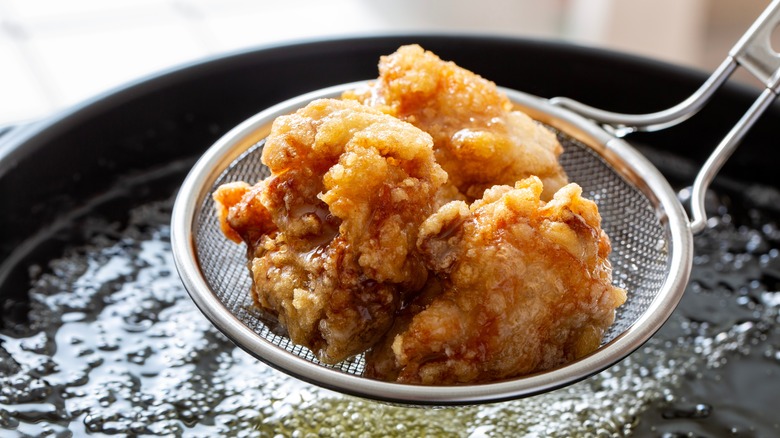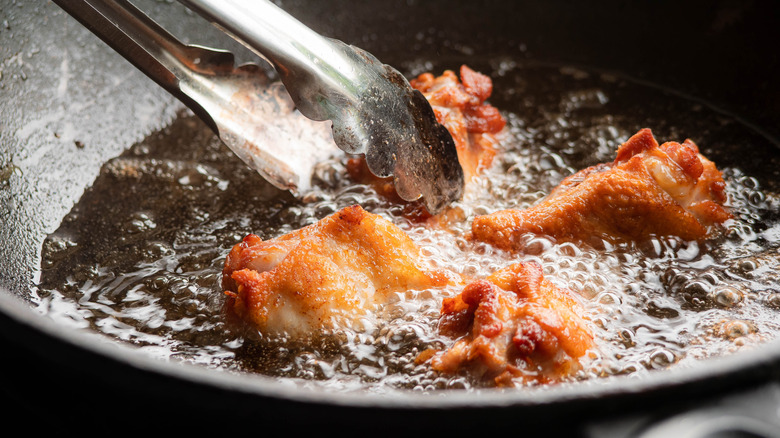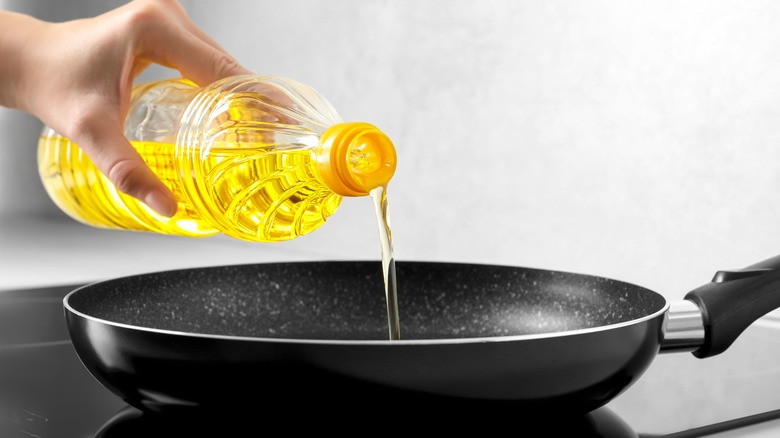Potato Starch Is The Key To The Crispiest Fried Chicken Ever
Crispy and crunchy, it's hard to beat a piece of fried chicken when it's made correctly. However, between the correct breading, hot oil temperature, and sufficient cooking time, it can be a feat to pull it off without encountering any problems. Though, there is at least one big secret to creating the perfect breading every time: using potato starch.
While American fried chicken uses traditional wheat flour for craggy edges and thick breading, Asian-inspired recipes opt for potato starch's crispy, thinner breading. Japanese cuisine has a history of using this method to fry foods and today you can also find this fried chicken across South Korea and even Taiwan.
The reason potato starch is so highly prized as a breading is its ability to get crispier and stay crunchier for longer compared to wheat flour used for American fried chicken. The gluten in wheat absorbs water from the meat and fat from the oil, which can lead to a soggy crust, but a starch will absorb much less moisture during the process. Potato starch is sold as a fine powder with a neutral taste, and since it's made entirely from spuds, this starch is a naturally gluten-free food.
If you'd like to switch up your method for frying chicken, grab a bag of potato starch at your local Asian market or the gluten-free section of grocery stores. Just be sure to not accidentally substitute potato flour, which is made from cooked, ground potatoes and won't give you the correct texture.
Tricks for frying chicken with potato starch
Any brand of potato starch will work for frying chicken, but some cooks swear by the Katakuriko brand. This particular variety is made from potatoes grown in the Hokkaido region of Japan, which is famous for its high-quality crops.
No matter which brand you choose, to use this potato starch tip, simply follow your favorite fried chicken recipe and swap in potato starch in place of the wheat flour or other main breading ingredient. This will result in extra crispy chicken every time, but if you can't get enough of that crunchy experience, consider double frying your chicken, too. This method involves initially cooking the poultry at a lower temperature, letting it rest, then frying it for a second time to create an ultra crackly texture.
Also, always fry chicken in smaller batches, as overcrowding will lower the oil temperature too much, resulting in the potato starch breading becoming greasy. In between batches, skim the oil to remove any floating bits. Otherwise they may burn and ruin the flavor of the remaining pieces of meat.
If you're hesitant to completely deviate from the classic method of breading chicken in wheat flour, you don't have to entirely skip on the benefits of potato starch. Using one part wheat flour to three-fourths potato starch will still result in a crispier breading while also keeping the craggly texture that is associated with American fried chicken.
Other tips for delicious fried chicken
While you may have breading all figured out now, if you're not marinating your chicken before the frying process you're missing out on a world of additional deliciousness. Adding this step will infuse the meat with flavor from the inside out and will help it maintain moisture, too. Try marinating the chicken in yogurt, mayonnaise, or buttermilk as a base. Season as desired and let it sit in the fridge for a minimum of two to three hours, or ideally overnight.
While it might be tempting to get the show on the road, battering and frying chicken right out of the fridge can lower the oil temperature and throw off your whole cooking process. Instead, allow it to sit out at room temperature for about a half-hour before breading.
When placing your chicken into the hot oil, be sure to position each piece with the skin side down. This ensures that the fat will render under the breading to become more crispy instead of flabby.
The final ingredient choice that can make or break your fried chicken is what type of oil you use. You need something with a high smoke point (the temperature at which the oil begins to burn and release dangerous compounds) that can withstand the highest temperature needed for frying chicken, which is 375 degrees Fahrenheit. Some popular choices include peanut, canola, and corn oils, all of which have smoke points above 400 degrees Fahrenheit.



